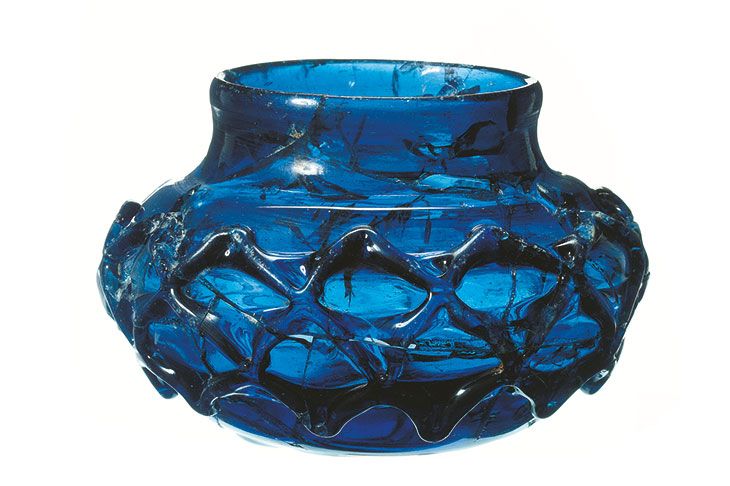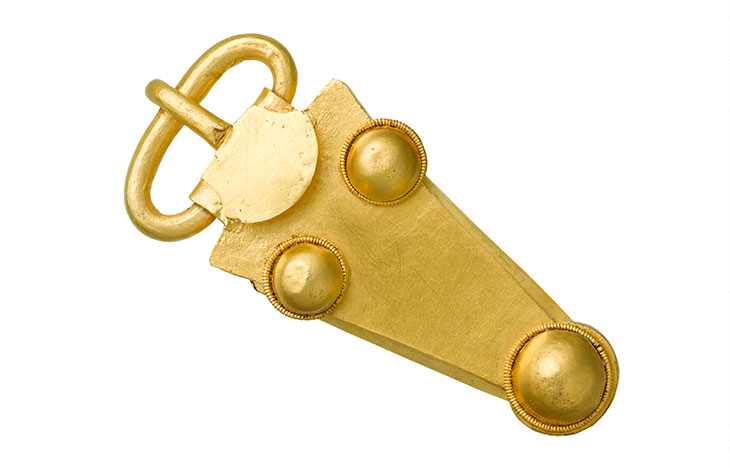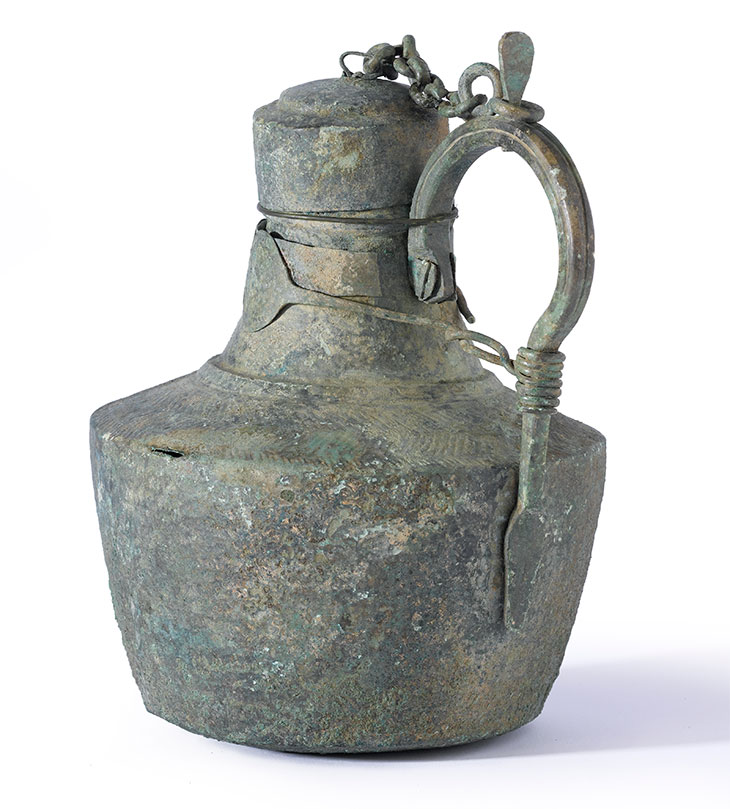Earlier this month it was announced that a spectacular group of artefacts from an Anglo-Saxon princely burial, unearthed in a plot of land in the shadow of an Essex Aldi in 2003, is to go on permanent display in Southend-on-Sea. The subterranean luxury of the Prittlewell site has an aura of paganism – evoking images of braided beards, metalwork and blood feuds. This is not totally unfounded, though the reality is more nuanced.
In around 580 AD, the deceased was placed in a wooden chamber, surrounded by the trappings of early medieval lordship. Weapons abound, including spears with intricately carved shafts and a deluxe sword blade, the core of which was formed of 64 twisted metal rods, welded together as four strips. The technique, known as ‘pattern welding’, lends resilience and leaves serpentine shapes on the polished blade, with all the iridescence of oil on water. In the Old English poem Beowulf, such swords are described as ‘woven’ or said to be ‘shining with venom-stripes [snakes]’. The weapons seem intended to identify the buried individual as a male warrior of princely status.

One of two blue glass decorated beakers found in the Prittlewell burial. © MOLA
Other artefacts, now documented and researched by the Museum of London Archaeology, support this impression. To an informed Anglo-Saxon eye, they would have represented imports from across the known world: a copper alloy flagon from Syria; a uniquely well-preserved lyre fitted with garnets from the Indian subcontinent; a silver spoon from the eastern Mediterranean; and the only extant folding stool to be found from Anglo-Saxon England, perhaps used for the typically Germanic ceremony of gift-giving in exchange for retainers’ loyalty. Furthermore, this ‘prince’ clearly had access to fine craftsmanship and materials, attested by the gold buckle thought to have been made especially for the burial, a painted box (the only surviving example of Anglo-Saxon polychrome woodwork), and two exceptionally rare and still intact blue glass beakers.

Gold belt buckle believed to have been made for the Prittlewell princely burial in the period between the death and the funeral. © MOLA
As well as geographical reach and material resources, the objects speak of leisure pursuits in which a lord would have indulged with his retinue. There are gaming pieces, a cauldron and horns for communal feasting, and the aforementioned lyre, which in particular inspires visions of the kind of secular entertainment found in Beowulf, here translated by Seamus Heaney:
They sang then and played to please the hero,
words and music for their warrior prince,
harp tunes and tales of adventure:
there were high times on the hall benches
In the Prittlewell burial, archaeology bears witness to literature, both fulfilling a modern fantasy of the Early Middle Ages. Yet, two artefacts complicate this vision of a purely pagan world: a pair of gold-foil Latin crosses. Based on the proximity of a few tooth fragments (all that remains of the tomb’s occupant) and knowledge of the practice from contemporary Merovingian graves, it can be assumed that the crosses were originally placed on the eyes of the deceased. These delicate sheets of gold leave little room for doubt that he had Christian connections – not unlikely given contemporary kings’ marriages to Christian women from the Continent, such as the Frankish princess-cum-saint Bertha of Kent. Indeed, look closely and the crosses are not an aberration in the scheme. The Syrian vessel is decorated with an image of the saints Sergius and Bacchus and is of a type purchased by Christian pilgrims to the shrine in Resafa, some 200 kilometres south-east of Aleppo. Was the iconography known to those responsible for the burial? If so, didn’t Christianity mean an end to grave goods? Didn’t it purport to scorn worldly glory?

Copper alloy flagon made in the eastern Mediterranean, probably Syria. © MOLA
In the burial’s apparent ambiguity, it is not alone. Beowulf is told by a Christian narrator. This feature of the poem was long seen by scholars as an interpolation by a monkish redactor, applied to a pagan original. However, more recently, the Christian element has been read as integral to the poem’s aesthetic unity. In another great Old English poem, the Dream of the Rood, Christ’s cross narrates the Crucifixion as though it were a retainer and Christ a warrior prince. It reframes the Passion narrative in terms palatable to an Anglo-Saxon audience, steeped in Germanic warrior culture: a culture that prized courage in battle and fidelity to one’s lord.
According to late antique hagiography, the saints on the Syrian vessel – Sergius and Bacchus – were high-status warriors who practised Christianity in secret. When they were discovered, their refusal to convert led to their martyrdom. If this was understood by designers of the Prittlewell burial, then this pair of faithful retainers would surely have exemplified the Germanic ideal of battle-ready soldiers and loyalty-till-death. In the burial chamber, as in Beowulf and the Dream of the Rood, elite secular culture and Christianity emerge pattern-welded together, complicating our view of the Anglo-Saxon world.
Amy Jeffs is writing a PhD at the University of Cambridge about the illustration of British history in later medieval England.

Unearthing the secrets of the Anglo-Saxon world
Drinking vessels with decorated gilt necks at the Prittlewell site. © MOLA
Share
Earlier this month it was announced that a spectacular group of artefacts from an Anglo-Saxon princely burial, unearthed in a plot of land in the shadow of an Essex Aldi in 2003, is to go on permanent display in Southend-on-Sea. The subterranean luxury of the Prittlewell site has an aura of paganism – evoking images of braided beards, metalwork and blood feuds. This is not totally unfounded, though the reality is more nuanced.
In around 580 AD, the deceased was placed in a wooden chamber, surrounded by the trappings of early medieval lordship. Weapons abound, including spears with intricately carved shafts and a deluxe sword blade, the core of which was formed of 64 twisted metal rods, welded together as four strips. The technique, known as ‘pattern welding’, lends resilience and leaves serpentine shapes on the polished blade, with all the iridescence of oil on water. In the Old English poem Beowulf, such swords are described as ‘woven’ or said to be ‘shining with venom-stripes [snakes]’. The weapons seem intended to identify the buried individual as a male warrior of princely status.
One of two blue glass decorated beakers found in the Prittlewell burial. © MOLA
Other artefacts, now documented and researched by the Museum of London Archaeology, support this impression. To an informed Anglo-Saxon eye, they would have represented imports from across the known world: a copper alloy flagon from Syria; a uniquely well-preserved lyre fitted with garnets from the Indian subcontinent; a silver spoon from the eastern Mediterranean; and the only extant folding stool to be found from Anglo-Saxon England, perhaps used for the typically Germanic ceremony of gift-giving in exchange for retainers’ loyalty. Furthermore, this ‘prince’ clearly had access to fine craftsmanship and materials, attested by the gold buckle thought to have been made especially for the burial, a painted box (the only surviving example of Anglo-Saxon polychrome woodwork), and two exceptionally rare and still intact blue glass beakers.
Gold belt buckle believed to have been made for the Prittlewell princely burial in the period between the death and the funeral. © MOLA
As well as geographical reach and material resources, the objects speak of leisure pursuits in which a lord would have indulged with his retinue. There are gaming pieces, a cauldron and horns for communal feasting, and the aforementioned lyre, which in particular inspires visions of the kind of secular entertainment found in Beowulf, here translated by Seamus Heaney:
They sang then and played to please the hero,
words and music for their warrior prince,
harp tunes and tales of adventure:
there were high times on the hall benches
In the Prittlewell burial, archaeology bears witness to literature, both fulfilling a modern fantasy of the Early Middle Ages. Yet, two artefacts complicate this vision of a purely pagan world: a pair of gold-foil Latin crosses. Based on the proximity of a few tooth fragments (all that remains of the tomb’s occupant) and knowledge of the practice from contemporary Merovingian graves, it can be assumed that the crosses were originally placed on the eyes of the deceased. These delicate sheets of gold leave little room for doubt that he had Christian connections – not unlikely given contemporary kings’ marriages to Christian women from the Continent, such as the Frankish princess-cum-saint Bertha of Kent. Indeed, look closely and the crosses are not an aberration in the scheme. The Syrian vessel is decorated with an image of the saints Sergius and Bacchus and is of a type purchased by Christian pilgrims to the shrine in Resafa, some 200 kilometres south-east of Aleppo. Was the iconography known to those responsible for the burial? If so, didn’t Christianity mean an end to grave goods? Didn’t it purport to scorn worldly glory?
Copper alloy flagon made in the eastern Mediterranean, probably Syria. © MOLA
In the burial’s apparent ambiguity, it is not alone. Beowulf is told by a Christian narrator. This feature of the poem was long seen by scholars as an interpolation by a monkish redactor, applied to a pagan original. However, more recently, the Christian element has been read as integral to the poem’s aesthetic unity. In another great Old English poem, the Dream of the Rood, Christ’s cross narrates the Crucifixion as though it were a retainer and Christ a warrior prince. It reframes the Passion narrative in terms palatable to an Anglo-Saxon audience, steeped in Germanic warrior culture: a culture that prized courage in battle and fidelity to one’s lord.
According to late antique hagiography, the saints on the Syrian vessel – Sergius and Bacchus – were high-status warriors who practised Christianity in secret. When they were discovered, their refusal to convert led to their martyrdom. If this was understood by designers of the Prittlewell burial, then this pair of faithful retainers would surely have exemplified the Germanic ideal of battle-ready soldiers and loyalty-till-death. In the burial chamber, as in Beowulf and the Dream of the Rood, elite secular culture and Christianity emerge pattern-welded together, complicating our view of the Anglo-Saxon world.
Amy Jeffs is writing a PhD at the University of Cambridge about the illustration of British history in later medieval England.
Unlimited access from just $16 every 3 months
Subscribe to get unlimited and exclusive access to the top art stories, interviews and exhibition reviews.
Share
Recommended for you
The cosmopolitan art of Anglo-Saxon England
The British Library demonstrates that Anglo-Saxon culture looked to Europe and beyond
The age of spectacular finds at Pompeii is far from over
The Great Pompeii Project’s restoration of the site has led to a stream of exciting discoveries
The pyramids at Giza looked very different when they were first built
The Egyptian pyramids were originally covered in smooth white limestone – as a casing stone now in Scotland shows